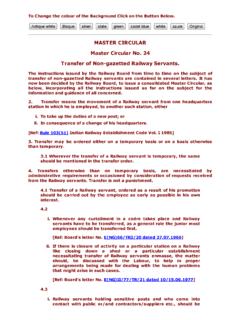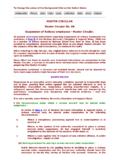Transcription of Projected Pay Scales after 7th Pay Commission - irtsa.net
1 1 | Page Projected PAY STRUCTURE after 7TH PAY Commission (BASED ON COMPARATIVE RISE FROM 1ST TO 6TH CPC) Demand for setting of Seventh Pay Commission is being raised since January 2011 on completion of 5 years since the date of effect of the sixth Pay Commission - as recommended by the last 2 Pay commissions. Till now six pay commissions had been constituted since 1946 - to review and recommend pay structure of central government employees. All the six pay commissions have taken many aspects into consideration to prescribe the pay structure for government servants.
2 In the first pay Commission the concept of living wage was adopted. In second pay Commission it had been reiterated that the pay structure and working condition to be crafted in a way so as to ensure the effective functioning of government mechanism. The third pay Commission adopted the concept of need based wage The Fourth CPC had recommended the government to constitute permanent machinery to undertake periodical review of pay and allowances of Central Government employees, but which got never implemented. In Fifth pay Commission all federations demanded that the pay scale should be at par with the public sector.
3 But the pay Commission didn t accept this and told that the demand for parity with the Public Sector was however difficult to concede as it felt that the Job content and condition of service in the government and public sector not necessarily the same. There were essential differences between the two sectors. The Sixth Central Pay Commission , claimed that it had not only tried to evolve a proper pay package for the Government employees but also to make recommendations rationalizing the governmental structure with a view to improve the delivery mechanisms for providing better services to the common man What about seventh pay Commission ?
4 Generally every pay Commission , before recommending a pay structure, analyzed all the aspects including the economic situation of the country, financial resources of the government, comparison with the public sector, private sector and state government pay structure etc. Pay Determination is very complicated and sensitive task. Without any doubt every one accepts that this is very challenging task too. In order to determine the new pay structure the pay Commission has to go through voluminous data consisting current economic condition, strength of the work force and working condition etc.
5 If one tries to suggest or comment about 7th pay Commission pay scale or about what the seventh pay Commission pay Scales , it will seem too pre-mature. However, we observed an interesting factor which is common to all the past pay Commission recommendations, particularly in the matter of percentage of increase in the pay. Average 3 times increase in the pay was recommended by each pay Commission and it was accepted by government and implemented (except that the rise was only about times after 6th CPC for the Scales from S4 to S23 and nearly 3 times or more for the higher Scales ).
6 Average increase after each Pay Commission - is shown in each of the following tables. Obviously it is simple thing, we can say it a mathematical coincidence that we have in common in all previous pay Commission , but we cannot neglect this. Because it was there, every time it is noticed that the revised pay was approximately three times higher than its pre revised pay. Apart from all the factors which has been used to determine the pay revision, we can use this simple formula common multiplying factor to know the 7th pay Commission pay scale . If next pay Commission prefer to continue the same running pay band and grade pay system for seventh pay Commission also, the pay structure may be like the following Projected figures given below, using common multiplying factor 3.
7 The Following is only the Projected figure using common multiplying factor 3 .. CONTINUED ---- 2 | Page SIXTH CPC PAY STRUCTURE Projected PAY STRUCTURE FOR 7th PAY Commission Name of Pay Band/ scale Corresponding Pay Bands Corresponding Grade Pay Entry Grade +band pay Projected entry level pay using uniform multiplying factor of `3 Band Pay Grade PayEntry Pay PB-1 5200-20200 1800 7000 15600-60600 5400 21000 PB-1 5200-20200 1900 7730 15600-60600 5700 23190 PB-1 5200-20200 2000 8460 15600-60600 6000 25380 PB-1 5200-20200 2400 9910 15600-60600 7200 29730 PB-1 5200-20200 2800 11360 15600-60600 8400 34080 PB-2 9300-34800 4200 13500
8 29900-104400 12600 40500 PB-2 9300-34800 4600 17140 29900-104400 13800 51420 PB-2 9300-34800 4800 18150 29900-104400 14400 54450 PB-3 15600-39100 5400 21000 29900-104400 16200 63000 PB-3 15600-39100 6600 25530 46800-117300 19800 76590 PB-3 15600-39100 7600 29500 46800-117300 22800 88500 PB-4 37400-67000 8700 46100 112200-20100 26100 138300 PB-4 37400-67000 8900 49100 112200-20100 26700 147300 PB-4 37400-67000 10000 53000 112200-20100 30000 159000 HAG 67000- (ann increment @ 3%) -79000 Nil 201000 HAG+ scale 75500- (ann increment @ 3%) -80000 Nil 226500 Apex scale 80000 (Fixed) Nil 240000 Cab.
9 Sec. 90000 (Fixed) Nil 270000 CONTINUED ---- 3 | Page Short Description about Sixth Pay Commission SIXTH PAY Commission Initially the then government refused to set up sixth pay Commission to review the pay and allowances of central government employees. The then finance minister told that there was no need to constitute next pay Commission since 50 % dearness allowance was already merged with the basic pay. The employees had threatened to go on a nationwide strike if the government failed to set up 6th pay Commission . In July 2006, the Cabinet approved setting up of the sixth pay Commission .
10 This Commission has been set up under the Chairmanship of Justice with a timeframe of 18 months to submit the report. The cost of hikes in salaries is anticipated to be about Rs. 20,000 crore for a total of million government employees. The Commission submitted the Report to the Government on March, 24, 2008. The Sixth Pay Commission mainly focused on removing ambiguity in respect of various pay Scales and mainly focused on reducing number of pay Scales . It recommended for removal of Group-D cadre. The Fifth CPC had compressed many Scales . The number of pay Scales was reduced from 51 pay Scales as on to 34 pay Scales by the Fifth CPC.




